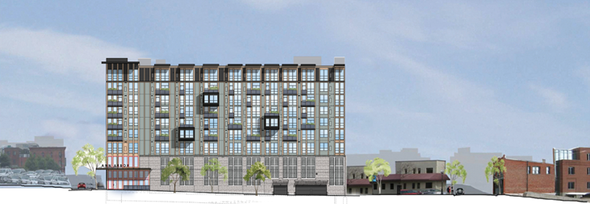Village Green project grows in height following Ann Arbor City Council approval
The Ann Arbor City Apartments project proposed by developer Village Green is now 10 feet taller than previously expected, and it includes a few new features.
The Ann Arbor City Council voted unanimously Monday night to approve revised elevations for the 156-unit complex, planned on 0.57 acres of city-owned land at First and Washington.
The developer submitted an administrative amendment to increase the maximum height of the building from 94 to 104 feet, a material change requiring council approval. Officials said the change was needed to bring the building out of the water table.

The latest drawing for Ann Arbor City Apartments, offering a look at the west elevation.
Image courtesy of developer
The City Council originally approved the site plan and development agreement to construct a nine-story residential building, along with a city-owned parking structure, in December 2008.
In addition to an increase in maximum building height, Village Green also was granted approval to modify the west elevation to allow the construction of an additional egress lane of traffic from the parking deck to First Street to better accommodate peak demand.
In September, the developer submitted construction drawings that showed the residential portion of the facade had changed from what City Council originally approved.
"The primary change in the elevations concern the type and size of windows," City Planner Jeff Kahan wrote in a memo. "The total amount of glazing is proposed to increase from 25 percent of the face of the building to 33 percent, an increase of 4,200 square feet of glass."
Other facade changes include two new air vents on the east alley side of the site. Kahan said the city's planning staff reviewed and supported the proposed changes.
Shawn Zimny, Village Green's vice president of development, sent the city a letter dated Oct. 4 explaining the changes to the project.
"In summary and as noted above, the revisions to the elevation as compared to the originally approved PUD elevation were due to issues having nothing to do with value engineering," he said. "But instead were a result of the final apartment layouts, code compliance issues and necessary structural, mechanical and compliance with green building standards."
The city owns the land for the project and expects to sell it to Village Green for $3.2 million, but the sale has been delayed multiple times.
Wendy Rampson, the city's planning manager, said the city attorney's office has been working on condominium documents for the project. She said city officials expect the sale of the property to happen sometime in November.
"It's one of these things where the construction drawings are actually in, but until they can figure out all of these other issues … it won't move forward," Rampson said.
Ryan J. Stanton covers government and politics for AnnArbor.com. Reach him at ryanstanton@annarbor.com or 734-623-2529. You also can follow him on Twitter or subscribe to AnnArbor.com's e-mail newsletters.


Comments
Veracity
Wed, Oct 19, 2011 : 4:21 p.m.
Ann Arbor City Apartments is destined for the same fate as Ashley Terrace. Hopefully, a white knight will come along and buy the bankrupt building for 30-cents on the dollar as with Ashley Terrace. At least the Ashley Terrace building is now occupied due to the marked reduction in leasing rates allowed by the low purchase costs. irrespective of the financial outcome of Ann Arbor City Apartments, the city taxpayers will have to contend with servicing the $9 million bond issue that the DDA will use to pay for the 156 subterranean parking structure. This annual expense may range from $750,000 to $900,000 depending on the coupon rate of the bonds and its life span. For sure parking fees at the present rate of $1.40 per hour will generate only $659,568, if every space is used 100% of chargeable time. Since the city averages 50% usage rate for its parking system, $420,000 to $570,000 will have to be provided from other sources to complete payments. New TIF payments are not projected to provide funds that will fill the void. Very likely a millage or income tax will be required to prevent default on bond payments. Exactly how will the city and its taxpayers benefit financially from this development?